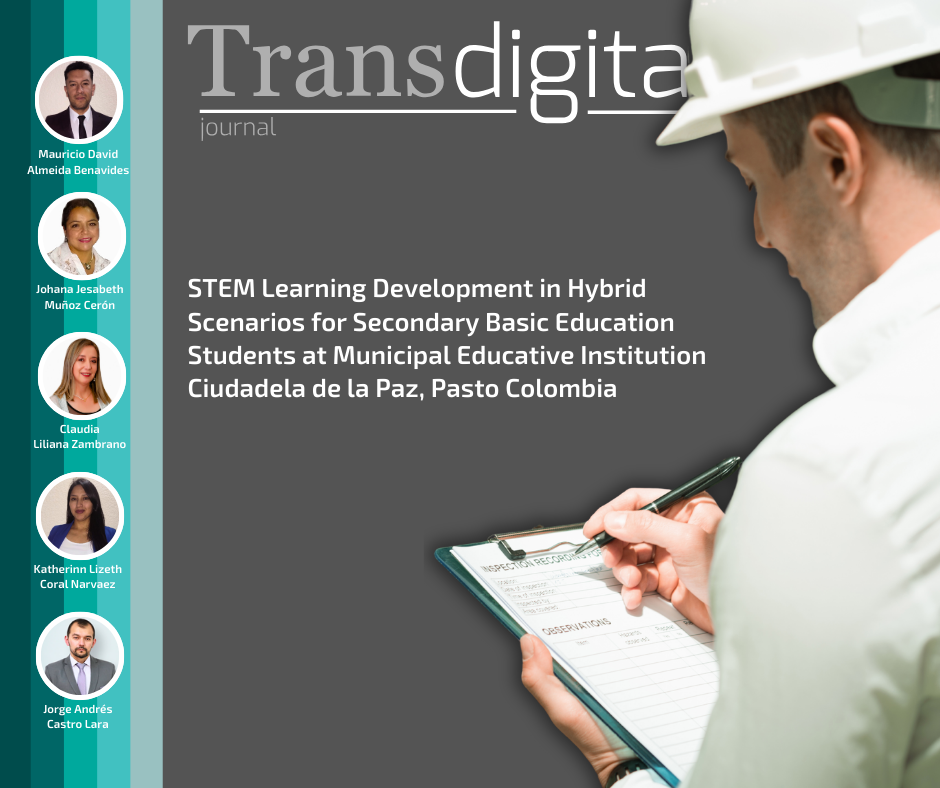STEM Learning Development in Hybrid Scenarios for Secondary Basic Education Students at Municipal Educative Institution Ciudadela de la Paz, Pasto Colombia
DOI:
https://doi.org/10.56162/transdigital295Keywords:
education, STEM, emerging technologies, robotics, ICTAbstract
The intervention proposal that was applied on at the Ciudadela de la Paz Educational Institution in Pasto, Colombia, for the setting in Science, Technology, Engineering and Mathematics (STEM) for Secondary students, incorporated significant innovations. First, it focused on implementing technological tools that facilitate learning, going beyond the recognition of the STEM environment. Second, it promoted collaborative work and the exchange of knowledge between students of different grades, which encouraged peer learning and developed social and technological skills. Thirdly, the proposal was aimed at enhancing students' prior knowledge about the use of technologies. The aim was to integrate this knowledge into learning scenarios and overcome educational obstacles. In addition, the strategy focused on strengthening pedagogical practices for the educational community, promoting the integration of its members in the teaching, and learning processes. The strategy included adaptation to new technological citizenships, emerging figures such as cybercitizens and digital citizens, which implies a significant change in social and educational dynamics. For the design of the intervention, the Design-Based Research approach was used, since it sought to establish systematic and collaborative educational innovation, intervening in the solution of educational problems, and incorporating new elements to transform the educational situation. The proposal was developed in a diverse educational context, considering socioeconomic and demographic challenges, and focused on adapting educational processes to Emerging Technologies to guarantee meaningful and accessible learning for all.
References
Buckingham, D. (2007). Media Education: Literacy, Learning and Contemporary Culture. Special Topics
Bybee, R. W. (2013). The Case for STEM Education: Challenges and Opportunities. NSTA Press
Collins, A. (1992). Toward a design science of education. In E. Scanlon, & T. O’Shea (Eds.), New directions in educational technology (pp. 15-22). New York: Springer-Verlag.
Dewey, J. (1938). Experience and Education. Kappa Delta Pi
Graham, C.R. (2006) Blended Learning Systems: Definition, Current Trends, and Future Directions. In Bonk, C.J., & Graham, C.R. (Eds.), Handbook of Blended Learning: Global Perspectives, Local Designs, Pfeiffer Publishing, San Francisco (3-21).
Hattie, J. (2009). Visible Learning: A Synthesis of Over 800 Meta-Analyses Relating to Achievement. Routledge
Jenkins, H., Purushotma, R., Weigel, M., Clinton, K., & Robison, A. J. (2006). Confronting the Challenges of Participatory Culture: Media Education for the 21st Century (Part One). The MIT Press
Jenkins, H., Purushotma, R., Weigel, M., Clinton, K., & Robison, A. J. (2009). Confronting the Challenges of Participatory Culture: Media Education for the 21st Century (Part Two). The MIT Press
Jiménez-Becerra, I., & Segovia-Cifuentes, Y. M. (2020). Models of didactic integration with ICT mediation: some innovation challenges in teaching practices (Modelos de integración didáctica con mediación TIC: algunos retos de innovación en las prácticas de enseñanza). Culture and Education, 32(3), 399-440. https://doi.org/10.1080/11356405.2020.1785140
Johnson, D. W., & Johnson, R. T. (1994). Learning Together and Alone: Cooperative, Competitive, and Individualistic Learning. Allyn and Bacon
Jonassen, D., Peck, K., & Wilson, B. (1999). Learning with Technology: A Constructivist Perspective. Merrill
Lave, J., & Wenger, E. (1991). Situated learning: Legitimate peripheral participation. Cambridge University Press
Lewin, K. (1946). Action research and minority problems. Journal of Social Issues, 2(4), 34–46.
Marrero-Galván, J. J., & Hernández-Padrón, M. (2022). La trascendencia de la realidad virtual en la educación STEM: una revisión sistemática desde el punto de vista de la experimentación en el aula. Bordón. Revista De Pedagogía, 74(4), 45–63. https://doi.org/10.13042/Bordon.2022.94179
Paredes-Labra, J., Freitas, A., & Sánchez-Antolín, P. (2019). De la iniciación al manejo tolerado de tecnologías. La competencia digital de los estudiantes madrileños antes de la educación secundaria. Revista de Educación a Distancia (RED), 19(61). https://doi.org/10.6018/red/61/03
Papert, S. (1980). Mindstorms: Children, Computers, and Powerful Ideas. Basic Books
Resnick, M. (2007). Sowing the seeds for a more creative society. Learning and Leading with Technology, 35, 18-22.
Tomlinson, C. A. (2001). How to Differentiate Instruction in Mixed-Ability Classrooms. Upper Saddle River
Vygotsky, L. S. (1978). Mind in Society: Development of Higher Psychological Processes. Harvard University Press
Wang, L., & Wang, J. (2012). Challenges and Strategies for Integrating STEM Education in the Classroom.
Wing, J. M. (2006). Computational Thinking. Communications of the ACM 49(3), 33-35. https://doi.org/10.1145/1118178.1118215

Downloads
Autor de correspondencia
El autor de correspodencia se identifica con el siguiente símbolo: *Published
How to Cite
License
Copyright (c) 2024 Mauricio David Almeida Benavides

This work is licensed under a Creative Commons Attribution 4.0 International License.
All articles in Transdigital are licensed under a Creative Commons Attribution 4.0 International License. Authors hold the copyright and retain publishing rights without restrictions.









